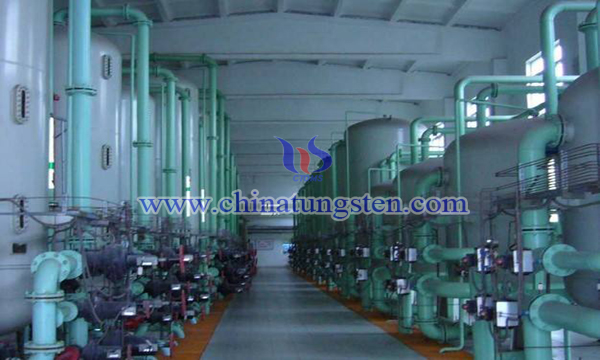Ammonium Paratungstate Ion Exchange Upgraded Version
- Details
- Category: Tungsten Information
- Published on Sunday, 07 October 2018 23:37
The traditional ion exchange process uses strong basic anion exchange resin 201 *7 to adsorb tungsten from alkaline sodium tungstate solution. Ammonium tungstate was obtained by evaporation crystallization of the obtained ammonium tungstate solution. The advantages of this process are short process, simple equipment, easy operation, low labor intensity, easy automation, reduced environmental pollution, workers'operating environment is good, and phosphorus, arsenic, silicon and other impurities have a certain purification effect.

However, the high chlorine content in ammonium tungstate solution affects the product performance of ammonium paratungstate during evaporation and crystallization, and the mother liquor of this process is difficult to be properly treated.
Recently, some scholars have improved the process of preparing ammonium paratungstate by ion exchange method, and then put forward a new method of preparing ammonium paratungstate. The process content is as follows:
1. The solution containing 0.15 mol / L sodium hydroxide and 22.5 g / liter of WO3 is used as the feed liquid. The feed contains 0.005g/L arsenic, 0.007g/L phosphorus, 0.012g/L molybdenum, 0.81g/L silicon dioxide and 0.17 mole/L chloride.
2.Tungsten is adsorbed on the resin column with porous strong basic anion exchange resin WA. The linear velocity of the feed through the resin column is 0.103 m/min. The resin exchange capacity is 380 mg / g dry resin. The concentration of tungsten trioxide in the effluent is less than 0.1 grams / liter WO3 and sent to the sewage treatment station.
3.The ion exchange resin loaded with tungsten was washed with deionized water, and the mixed solution of 4.5 mol/L ammonium chloride and 5.5 mol/L ammonium hydroxide was used as desorbent. The tungsten was eluted from the ion exchange resin by the ion exchange resin loaded with tungsten at a linear speed of 0.044 m/min. The adsorption rate was 99.0% and the recovery rate was 98.7%.
4.The content of tungsten trioxide is 320.6 g/L WO3 in ammonium tungstate solution, and 0.8 mole/L ammonium chloride and 2.1 mole/L ammonium hydroxide are also contained in the desorption solution. The removal efficiency of silicon is 99.1%, phosphorus removal is 96.9%, and arsenic removal rate is 95.6%.
The desorption solution was evaporated at ambient pressure and boiling temperature. The density of the desorption solution was 1.03 g/cubic centimeter. The solid-liquid separation was carried out by filtration. The separated ammonium paratungstate was dried at 95 ℃ and baked for 4.5 hours. After baking, the ammonium paratungstate crystallized.
In order to remove the molybdenum from the crystallized mother liquor after separation, the amount of sodium sulfide added is 140% of the theoretical amount. The mother liquor is heated to 70 ℃ for half an hour. The PH of the mother liquor is adjusted to 2.7 by 2.4 mole/liter hydrochloric acid. After the molybdenum precipitates, the precipitation is removed by filtration.
This process can not only eliminate the crystallization of ammonium paratungstate in the process of ion exchange, but also solve the problem of recovery of mother liquor after separation and crystallization. The final product of ammonium paratungstate has a Freund particle size of 20-50 micron and a bulk density of 1.6-2.30 g/cubic centimeter. The product has good crystallization performance and low cost. It can be used for drawing tungsten wires or raw materials for cemented carbide.
- APT Manufacturer & Supplier, Chinatungsten Online: ammonium-paratungstate.com
- Tungsten News & Prices of China Tungsten Industry Association: www.ctia.com.cn
- Molybdenum News & Price: news.molybdenum.com.cn
- Tel.: 86 592 5129696; Fax: 86 592 5129797; Email: sales@chinatungsten.com



 sales@chinatungsten.com
sales@chinatungsten.com